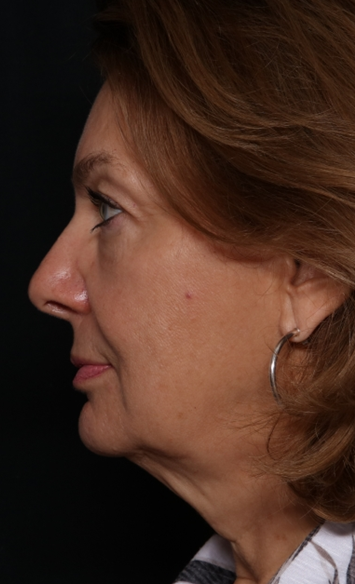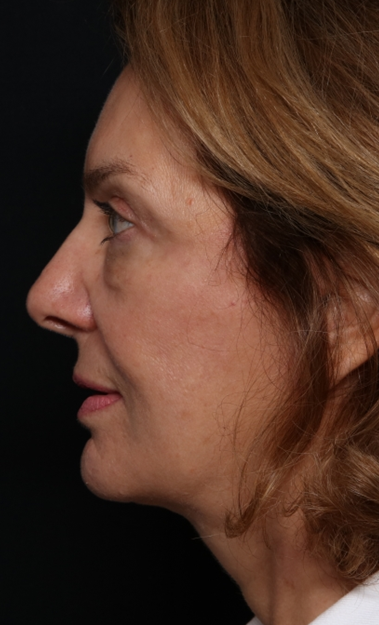Facelift
Offered at our convenient location in New Jersey

As the face ages, gravity begins to take its toll on your facial structures. The skin loses elasticity, wrinkles become more apparent, and the skin’s youthful brightness begins to fade.
The key to aging is volume. Volume loss occurs over time creating emptiness as well as sagging jowls and facial contour changes. A facelift performed by Brian S. Glatt, MD, FACS will take years off of your appearance by restoring youthful volume that has been lost, reducing wrinkles, restoring contours of youth by shifting volume back up where it came from and smoothing the skin’s surface. These facelift results can be further enhanced with medically supervised skin care by our experienced Medical Aestheticians.
Dr. Glatt, a Board Certified Plastic Surgeon, excels at facelift procedures, and has achieved dramatic results for many patients in New Jersey, including Morristown, as well as throughout the tri-state area. He combines his knowledge of different facelift techniques with a fine eye for detail and aesthetics, and outstanding technical skills in order to achieve dramatic, yet natural-looking results.
Your facelift results can be further enhanced by pre- and postoperative manual lymphatic drainage (MLD) massage as well as medically supervised skin care, all included with your facelift and performed by specialists at Dr. Glatt’s New Jersey office.
Contents
Facelift Facts
A facelift can make you look and feel years younger by restoring volume, firming muscle tone, smoothing skin, and restoring a more defined jawline and youthful face and neck contours.
Dr. Glatt will first address underlying facial structures in order to create the foundation for a more appealing contour. Incisions are placed discreetly around the hairline and ears in order to separate the skin from underlying facial structures. Deeper facial tissues are then tightened and lifted. With the restored foundation now set, excess skin is carefully trimmed away, and skin is repositioned to create a smooth and firm outward appearance.
During your initial facelift consultation with Dr. Glatt at his Morristown New Jersey practice, he will carefully examine and analyze your facial contours and skin type. Together, you will discuss and decide on the best method for achieving your desired results.
Before and After Photos
WHAT TO EXPECT FOLLOWING YOUR FACELIFT
We provide our patients with instructions on how to achieve a positive, healthy recovery.
Board Certified Plastic Surgeon Brian S. Glatt MD, FACS and his experienced staff believe a vital component to an optimal surgical outcome is advance preparation. For this reason, all surgical patients are given their post-operative prescriptions and directions for use of each medication prior to surgery. All patients are also provided with specific written post-procedure instructions, as well as information outlining what to expect following their facelift surgery.
- Your bandages will be removed 2-3 days after surgery in the office by Dr. Glatt. Expect bruising and swelling and some discomfort for the first 24-48 hours. Do not hesitate to take the pain medication ordered for you. Remember, it may make you feel drowsy and constipated. Valium may also be taken and if necessary, combined with the pain medicine or taken in its place.
- Please make sure to take your Sinecch arnica supplement as instructed on the box. This is important to your recovery and will significantly aid in bruising and swelling. Do NOT take any aspirin or aspirin-containing products or anti-inflammatories (Bufferin, Excedrin, Advil, Motrin, etc.) for the next 2 WEEKS. Aspirin interferes with normal blood clotting. If needed, you may take Tylenol products.
- When resting, try to stay on your back and elevate your head on two pillows as much as possible. Sleep on your back with your head elevated by 2-3 pillows. Continue this for the first week. Do NOT flex your neck (chin to chest) or turn sharply side to side.
- Eat soft foods; anything that does not require vigorous chewing. Gradually resume your diet over the next 2-3 days. Protein shakes (Boost or Ensure) are also a great way to keep your nutrition up without too much chewing.
- You may start showering and washing your hair after seeing Dr. Glatt at your first visit. However, since you will have some numbness of the face and earlobes, do NOT use hot rollers or sit under a hair dryer. Use a hand blower on a cool setting. Do not color or perm your hair for six weeks. After showering, be careful to gently pat the incision areas dry. You can then apply a small amount of antibiotic ointment (Neosporin, Polysporin, Bacitracin, etc.) to your suture lines after washing your hands.
- You may experience numbness along the incision lines and possibly swelling and numbness in your earlobes. These symptoms are normal and will lessen over time (6-12 months). You may use make-up to camouflage the bruising on your face and neck, being careful not to apply it too close to or on the suture lines until cleared to do so by Dr. Glatt. It is important to remove make-up thoroughly at the end of the day.
- You will feel tired. This is a common side effect from both the general anesthesia and the surgery. Your activity will be restricted for three weeks. You should not undertake strenuous activities like aerobics, tennis, or heavy lifting. After this period, you may begin to gradually work up to your previous level of exercise. It may be 4-6 weeks before you feel that your energy level has returned to normal. Pace yourself and allow for rest periods during the day. When you return to work, consider working only half days (preferably the second 1/2 of the day).
- You will have sutures that need to be removed. Most of these will be removed 1 week after your surgery, and the remainder 2 weeks after surgery. You may begin to use camouflage make-up after suture removal.
- You may drive 1 week after surgery if you feel up to it and are not taking prescription pain medicine. Avoid alcoholic beverages for at least 1 week as alcohol can interfere with your medications. It also tends to increase swelling and bleeding.
- Signs and Symptoms to report to Dr. Glatt: a temperature above 101, Chills, excessive redness or swelling of incision lines, Any drainage or separation of suture lines, Excessive or worsening eye pain, any problems with vision.
Please feel free to call our office with any questions or concerns. We want you to be as comfortable as possible during the healing process.
DRAIN CARE INSTRUCTIONS
Drains are placed under the skin during surgery to remove residual blood or other fluids that may collect there. Surgical drains decrease the chance of infection, decrease the chance of fluid collections accumulating under the skin, and promote wound healing. It is important that the drain be left in place until the drain output decreases to reasonable levels (This is usually less than 30 ML over a 24 hour period).
You do not need to stay in the hospital until the drain is ready to be removed. The instructions below will help you to care for the drains at home. If you have any questions, please do not hesitate to call our office.
INSTRUCTIONS FOR EMPTYING THE DRAIN
- Wash your hands
- Remove plug from pouring spout
- Pour drainage into measuring cup (provided to you)
- Flatten the drain container (squeeze it) and replace the plug into the spout while maintaining hold
- Record the date, time, and amount of drainage (in cc or ml, Do NOT measure in ounces) on the recording sheet provided. In addition, note any problems you have encountered.
- Empty the containers two to three times per day.
- Do not worry if clotted material shows up in the drains. This is normal and does not indicate a problem. The drain fluid may change color and become more clear (from red, to orange, to yellow) This is normal and to be expected. The overall amount should also decrease over time.
- You should treat the area where the drain exits your skin with some antibiotic ointment of your choice (such as Neosporin, Bacitracin, etc…) 2-3 times per day.
- You may shower with your drain in place (Occasionally, Dr. Glatt will not want you to shower with your drain. He will let you know if this is the case). To do this you may put a string or shoelace around your neck and safety pin the drains to the string or you can safety pin the drains to a hanging towel. Just let soap and water run over the site – do not actively scrub the drain site. Pat the area dry with a clean towel afterwards and apply antibiotic ointment.
THINGS TO REPORT TO OUR OFFICE
- Redness or drainage around the drain site
- Fevers > 101
- Inability to keep the drainage container flat and on suction
- Sudden stoppage of drainage fluid into the container
Contact Dr. Glatt for a Facelift Consultation
Dr. Glatt customizes his facelift procedure and can create a combination of procedures to fit your individual needs and desired results. He does not believe that one technique is right for everyone, and as such, he has the surgical knowledge and skills necessary to address your particular needs. Schedule a consultation with Dr. Brian S. Glatt and learn more about your facelift options by contacting his New Jersey practice.










